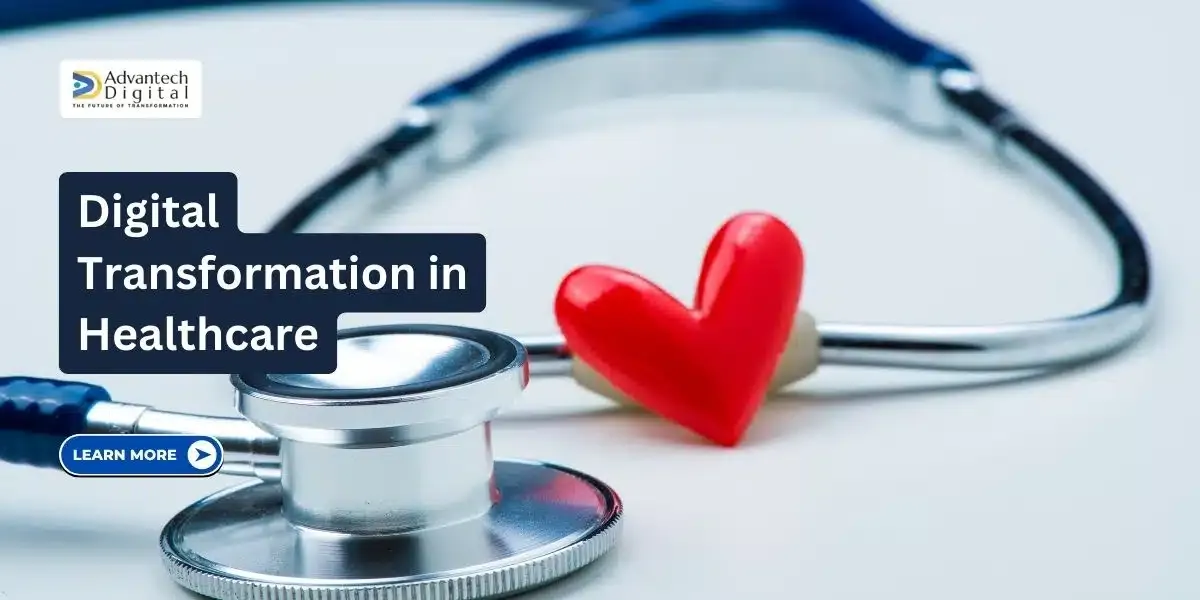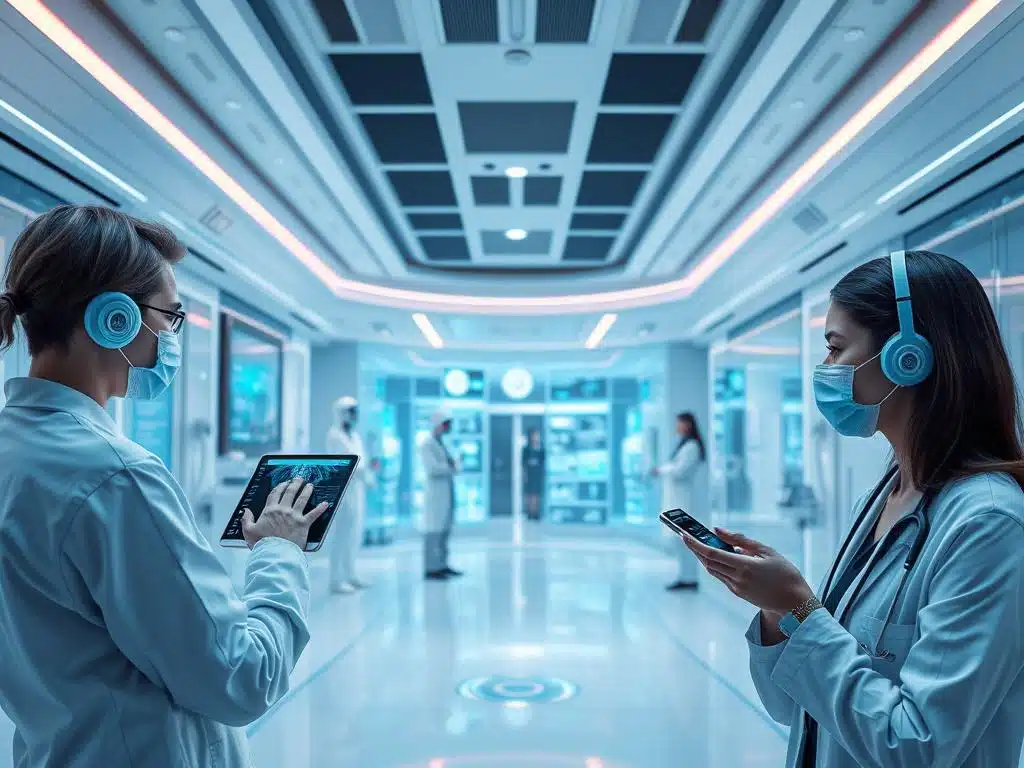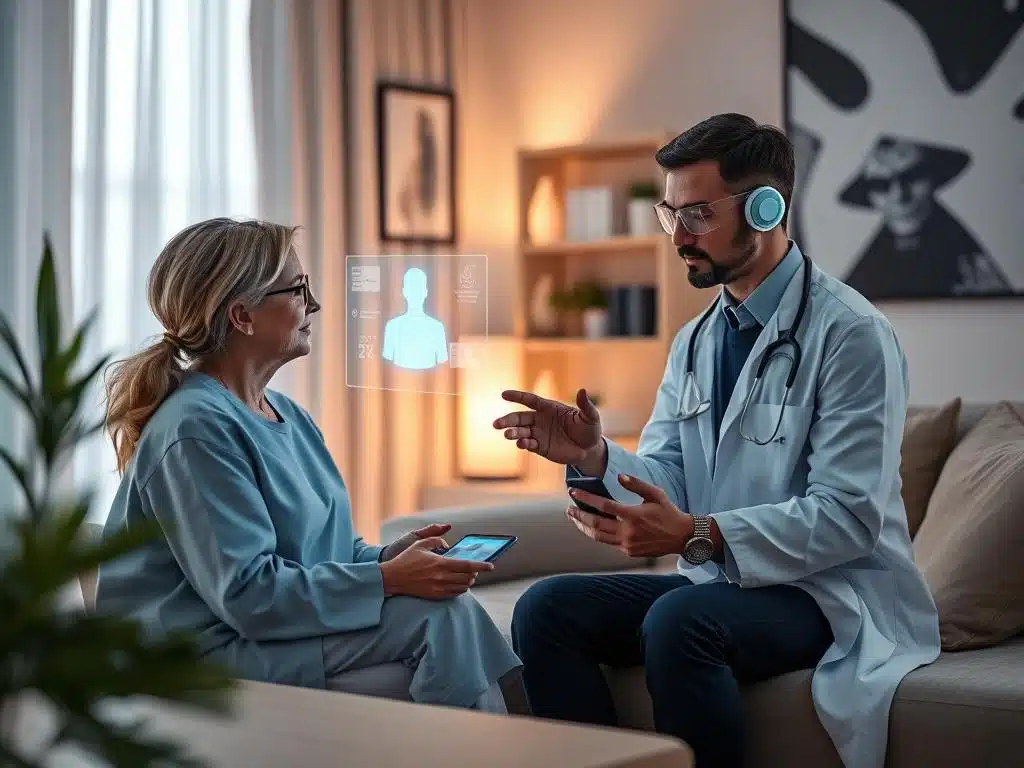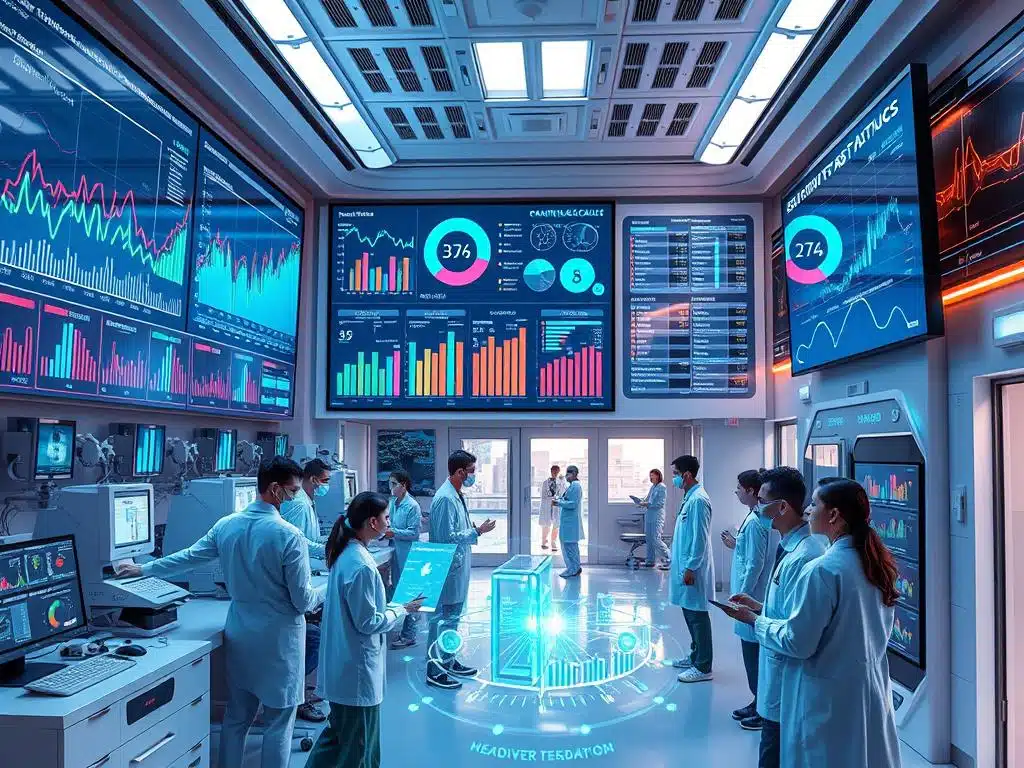The healthcare sector is on the brink of a technological revolution. The Digital transformation strategies in healthcare Only 7% of healthcare companies have gone digital, compared to 15% in other industries. This gap presents a massive opportunity for growth and innovation.
U.S. national health spending is projected to hit $5.7 trillion by 2026. To remain competitive, healthcare providers must leverage cutting-edge technologies. These include artificial intelligence, machine learning, virtual reality, and wearable devices.
Digital transformation is crucial for healthcare organizations to unlock new capabilities. It enhances patient experiences and optimizes workflows. AI and machine learning could save $200-$360 billion in healthcare spending by 2025.
However, the digital journey isn’t without obstacles. Many healthcare executives prioritize digital transformation but lack resources or planning. The evolving digital landscape also brings new risks, like cybersecurity threats.
Key Takeaways
- Digital transformation is a top priority for healthcare organizations, with cutting-edge technologies set to revolutionize patient care, medical processes, and operational efficiency.
- Healthcare providers must align digital efforts with strategic goals and deliver meaningful value to stay competitive and unlock new capabilities.
- AI and machine learning have the potential to result in significant net savings in healthcare spending by 2025.
- Healthcare executives face challenges in digital transformation, including insufficient resources and planning, cybersecurity risks, and the need for robust governance frameworks.
- Embracing digital transformation strategies is crucial for healthcare organizations to enhance patient experiences, optimize workflows, and drive the future of healthcare.
Embracing Artificial Intelligence and Machine Learning
Artificial intelligence and machine learning are revolutionizing healthcare. These technologies are transforming diagnosis, treatment, and patient care management. They’re driving digital transformation in healthcare, improving outcomes and efficiency while reducing costs.
Enhancing Diagnostic Accuracy
AI and ML significantly improve diagnostic accuracy in healthcare. They analyze vast amounts of medical data to detect subtle patterns and anomalies. By 2025, AI and ML adoption in healthcare is expected to increase by 40%.
Machine learning algorithms analyze medical images with unparalleled precision. This enables early disease detection and reduces the burden on healthcare professionals. It allows them to focus on complex cases and patient care.
Personalizing Treatment Plans
AI and ML enable personalized treatment plans based on individual patient data. They analyze medical history, genetic profiles, lifestyle factors, and real-time health metrics. This helps healthcare providers develop targeted interventions and therapies.
“The impact of artificial intelligence (AI) on healthcare growth has significantly improved diagnostic accuracy, treatment plans, and patient outcomes.”
AI-powered personalized medicine revolutionizes chronic disease and cancer treatment. It also helps with rare genetic disorders. Tailored treatment plans optimize outcomes, minimize side effects, and improve quality of life.
Optimizing Operational Efficiency
AI and ML are transforming healthcare operations. They automate routine tasks, streamline workflows, and optimize resource allocation. This drives unprecedented efficiency gains in healthcare organizations.
Digital transformation with AI, ML, and RPA has reduced operational costs by 25%. These technologies improve appointment scheduling, patient triage, claims processing, and supply chain management. They allow healthcare providers to focus on delivering high-quality care.
Balancing technological advancements with human expertise is crucial. AI and ML augment medical professionals’ capabilities but can’t replace human judgment. Fostering a symbiotic relationship between technology and healthcare professionals unlocks the full potential of these transformative technologies.
Leveraging Virtual and Augmented Reality
Virtual reality (VR) and augmented reality (AR) are transforming healthcare. These tools revolutionize medical education, training, and patient treatment. They offer immersive experiences that enhance learning, precision, and outcomes.
The global healthcare VR market exceeded $4 billion in 2024. More facilities adopt this technology for simulations, therapy, and pain management. VR enables medical professionals to engage in immersive, low-risk training scenarios.
It allows them to develop critical skills in a safe environment. Students can practice complex procedures without real-world risks.
Transforming Medical Education and Training
VR and AR provide realistic simulations and interactive learning experiences. Medical students can practice procedures, explore anatomy, and interact with virtual patients. This approach enhances knowledge retention and skill development.
It also boosts confidence among future healthcare professionals. The immersive environment allows for repeated practice and immediate feedback.
| Technology | Applications | Benefits |
|---|---|---|
| Virtual Reality (VR) | Surgical simulations, anatomy education, patient simulation | Immersive learning, risk-free practice, improved skill development |
| Augmented Reality (AR) | Surgical guidance, medical visualization, patient education | Enhanced precision, real-time information, improved patient understanding |
Enhancing Patient Experience and Treatment
VR and AR are transforming patient experience and treatment options. AR-assisted surgeries provide real-time information, enhancing precision and reducing complications. VR therapy offers non-invasive options for pain management, phobia treatment, and rehabilitation.
Studies have shown that VR and AR interventions are effective in reducing acute pain from medical procedures associated with transient pain among adults and youth.
VR and AR technologies show promising results in managing chronic pain. Evidence for long-term effects is limited. However, ongoing research suggests VR exposure can reduce chronic pain intensity during treatment sessions.
Healthcare’s digital transformation embraces VR and AR technologies. These tools improve care quality, patient outcomes, and cost-efficiency. They offer innovative, personalized solutions for patients and medical professionals alike.
Implementing Robust Cybersecurity Measures
Healthcare’s digital transformation demands strong cybersecurity to protect patient data and maintain trust. The sector faces an average cost of $9.77 million per data breach. Prioritizing data protection and complying with HIPAA and GDPR is crucial for healthcare organizations.
In the past year, 92% of healthcare organizations experienced a cyberattack. Phishing was the most common initial point of compromise. Over 58% reported phishing as their most significant security incident’s cause.
To combat these threats, providers must invest in advanced security solutions. Regular penetration tests are necessary to identify vulnerabilities. These measures help safeguard sensitive information and maintain regulatory compliance.
Safeguarding Patient Data and Electronic Medical Records
Patient data is the most valuable information on the black market. This makes healthcare a prime target for cyberattacks. Clinicians increasingly use personal devices, complicating endpoint security management.
To mitigate risks, organizations must implement strict access controls and encrypt sensitive data. Comprehensive cybersecurity training for staff is essential. This approach helps protect patient information and maintain trust.
“Humans remain the weakest link in cybersecurity.”
Training programs should cover strong password management and recognizing phishing attempts. Secure data handling and device security are also crucial topics. Open communication between IT professionals and healthcare staff fosters security awareness.
Ensuring Compliance with HIPAA and GDPR
Healthcare organizations collect vast amounts of patient data. Compliance with HIPAA and GDPR is non-negotiable. Failing to meet these standards can result in severe penalties and reputational damage.
To ensure compliance, providers must conduct regular risk assessments. Implementing data protection policies and procedures is crucial. Encrypting sensitive data both at rest and in transit adds another layer of security.
- Conduct regular risk assessments
- Implement data protection policies and procedures
- Encrypt sensitive data both at rest and in transit
- Provide staff training on data privacy and security
- Establish incident response plans
Prioritizing cybersecurity and data privacy protects patient information and maintains trust. This focus allows healthcare organizations to deliver high-quality care in the digital age. Robust security measures ensure patient confidentiality and regulatory compliance.
Advancing Telemedicine and Remote Patient Monitoring
The COVID-19 pandemic has revolutionized healthcare delivery through telemedicine and remote patient monitoring. Connected health technologies have made telehealth services more accessible. Patients now enjoy convenient medical care without in-person visits.
Telemedicine use among office-based physicians surged from 15% in 2019 to 86% in 2021. Primary care physicians lead with 91% adoption. Medical specialty physicians follow at 87%, while surgical specialists reach 75% in virtual care use.
Rural patients benefit significantly from telemedicine and remote monitoring. These technologies bridge gaps in underserved regions. Healthcare providers can now reach medically complex patients in areas with acute workforce shortages.
| Metric | Before | After | Change |
|---|---|---|---|
| Disease-specific markers | 12,000 | 11,000 | -8.3% (p = 0.002) |
| Severity of symptoms | 3,500 | 2,500 | -28.6% (p < 0.001) |
| General health status | 7,200 | 8,500 | +18.1% (p < 0.001) |
| Direct healthcare costs | 25,000 | 12,000 | -52.0% (p < 0.001) |
| Indirect healthcare costs | <10,000 | <5,000 | -50.0% (p = 0.004) |
Telemedicine and remote monitoring greatly impact patient outcomes and satisfaction. Studies show reduced disease markers and symptom severity. General health status has improved, while healthcare costs have decreased substantially.
Patient satisfaction with communication increased from 80% to 95%, and satisfaction with the convenience of services rose from 75% to 90%. Overall patient satisfaction significantly increased from 80% to 95%.
Digital transformation in healthcare continues to evolve. Telemedicine and remote monitoring improve care, reduce costs, and enhance patient experiences. These technologies create a more connected and efficient healthcare system.
By breaking down geographic barriers, accessibility increases. This paves the way for a more patient-centric approach to healthcare delivery. The future of medicine looks brighter with these advancements.
Harnessing the Power of Big Data Analytics
Big data analytics is revolutionizing healthcare, offering new ways to improve population health and optimize resources. Healthcare organizations can gain valuable insights by leveraging vast amounts of patient data. These insights drive better decision-making and enhance overall health outcomes.
A study of 217 Polish medical facilities shows growing adoption of big data analytics in healthcare. The market is projected to reach $34.16 billion by 2025. This growth reflects the shift towards patient-centered care and the need for effective analytical tools.
Improving Population Health Management
Big data analytics plays a key role in population health management. Predictive models analyze Electronic Health Records to identify high-risk populations. This enables targeted interventions and preventive care.
Advanced analytics techniques like machine learning power these models. They can anticipate post-surgical complications, heart failure, or substance abuse. This empowers healthcare providers to deliver proactive, personalized care to patients.
Optimizing Resource Allocation and Staffing
Big data analytics optimizes resource allocation and staffing in healthcare organizations. It forecasts patient volumes and analyzes historical data to predict staffing needs. This enhances operational efficiency and helps reduce healthcare costs.
The growing demand for big data analytics creates exciting job opportunities. Roles like health informatics specialist and healthcare data analyst are in high demand. As organizations embrace data-driven decision-making, the need for skilled professionals will continue to rise.
Healthcare organizations must prioritize data literacy to capitalize on big data analytics. They should embed data-driven insights within their culture and decision-making processes. Adopting an enterprise data strategy and leveraging cloud technology can upscale data management effectively.
Integrating Wearables and Internet of Medical Things (IoMT)
Wearable technology in healthcare and the Internet of Medical Things (IoMT) are transforming patient care. These connected devices enable personalized care and remote monitoring. Healthcare providers can now improve patient outcomes and boost operational efficiency.
IoMT creates a network of connected medical devices, software, and health systems. These tools collect, analyze, and transmit health data continuously. Devices include fitness trackers, intelligent implants, and remote monitoring systems.
IoMT empowers healthcare providers to detect issues early and manage chronic conditions effectively. This technology can significantly reduce complications and improve overall patient care.
“The Internet of Medical Things (IoMT) is expected to expand with advancements in sensor technology, connectivity, and data analytics, facilitating real-time monitoring, remote patient care, and early detection of health issues.” [7]
IoMT adoption offers numerous benefits to healthcare providers and patients alike. It reduces administrative burdens and minimizes hospital readmissions. The technology also optimizes resource allocation and lowers healthcare costs.
Real-time data transmission through IoMT enables early intervention, leading to better patient outcomes. However, challenges like data security and interoperability must be addressed. Cost and regulatory compliance are also important factors to consider.
The future of IoMT looks promising, especially when combined with artificial intelligence (AI). Advanced wearables, implantables, and automated healthcare facilities are on the horizon. Big data analytics will play a crucial role in this evolution.
To unlock IoMT’s full potential, ethical considerations must be addressed. Patient consent, data privacy, and equitable access are key issues. By tackling these challenges, we can achieve true digital transformation in healthcare.
Streamlining Electronic Health Records (EHR) Management
Healthcare organizations prioritize streamlining electronic health records (EHR) management in today’s evolving landscape. Digital transformation strategies enhance EHR systems’ efficiency and effectiveness. This improvement ultimately leads to better patient care and outcomes.
Streamlined EHR management significantly improves patient care and safety. Healthcare professionals can reduce medical errors with faster access to critical information. Recent studies show enhanced care coordination among departments, resulting in improved patient outcomes.
Enhancing Interoperability and Data Sharing
Effective EHR management relies on interoperability and data sharing. Healthcare organizations focus on improving EHR interoperability to facilitate seamless health information exchange. Adopting standardized data formats and APIs enables secure patient data sharing, reducing errors and duplication.
Innovative technologies like blockchain ensure data integrity and secure EHR sharing. This enhanced collaboration and access to patient information lead to better-informed decisions. Consequently, healthcare providers can develop more personalized treatment plans.
Improving Patient Engagement and Access
Patient engagement and access are vital in modern healthcare. Integrating patient portals with EHRs empowers patients to participate in their care actively. These portals allow patients to access records, schedule appointments, and communicate with providers.
The introduction of patient portals has increased patient empowerment in managing their health. Case studies reveal higher satisfaction as individuals appreciate convenient access to health information. This engagement fosters a more collaborative approach to healthcare.
| Benefits of Streamlined EHR Management | Impact |
|---|---|
| Improved patient care and safety | Reduced medical errors and adverse events |
| Enhanced care coordination | Better collaboration and improved patient outcomes |
| Streamlined administrative tasks | Time savings and reduced paperwork |
| Increased patient engagement | Empowered patients actively participating in their care |
The future of EHR management looks promising as healthcare organizations embrace digital transformation. Advanced technologies like AI and machine learning will make EHR systems more efficient. These improvements will prioritize patient engagement and empowerment.
Implementing Cloud Computing Solutions
Cloud computing is transforming healthcare, revolutionizing medical data management. It offers scalability, cost-efficiency, and enhanced collaboration. Understanding its impact is crucial for the future of healthcare delivery.
Leading IT companies are investing heavily in cloud-based healthcare solutions. McKinsey projects these solutions to be worth $100-170 billion by 2030. This growth stems from optimized costs, improved interoperability, and enhanced customer experience.
Enabling Scalability and Cost-Efficiency
Cloud computing provides scalability and cost-efficiency in healthcare. Organizations can easily adjust resources to meet changing demands without large upfront investments. This flexibility allows pay-per-use models, reducing costs associated with on-premise systems.
Philips Healthcare demonstrates significant cost savings through cloud adoption. They’ve developed innovative solutions like the Patient Flow Capacity Suite and Acute Care Telehealth. These advancements showcase the potential for improved efficiency and patient care.
Facilitating Collaboration and Data Sharing
Cloud platforms enable secure data sharing and collaboration among healthcare teams. Centralizing medical data allows professionals to access patient information anytime, anywhere. This leads to better care coordination and more informed decision-making.
Cloud computing in healthcare facilitates seamless collaboration between clinicians, researchers, and patients. It enables a more holistic approach to healthcare delivery. Cloud storage provides scalable solutions for managing and analyzing vast amounts of data.
Researchers can leverage big data analytics to detect medical conditions using clinical images. This data-driven approach opens new possibilities for personalized medicine and predictive analytics.
| Year | Number of Research Articles |
|---|---|
| 1971 | 2 |
| 2021 | 680 |
The table above illustrates the remarkable growth in research articles related to cybersecurity and healthcare, highlighting the increasing importance of data security in the cloud computing era.
“Cloud computing in the healthcare sector provides significant benefits such as optimizing overall costs, promoting interoperability, giving ownership of patients’ data, improving collaboration, and enhancing the customer experience.”
Prioritizing data security and privacy is essential in healthcare cloud computing. Robust cybersecurity measures must protect sensitive medical information from threats. Compliance with HIPAA and GDPR builds trust and safeguards data integrity.
The future of healthcare is cloud-powered, offering endless possibilities. It enables telemedicine, remote patient monitoring, and AI applications. Digital transformation strategies are crucial for this paradigm shift.
Cloud computing is driving a more connected, efficient healthcare system. It promises better outcomes for all, revolutionizing patient care and medical research. The era of cloud-based healthcare is here, transforming the industry.
Adopting Blockchain Technology
Blockchain technology is revolutionizing healthcare. It enhances data security, interoperability, and supply chain management. This innovation, originating in 2008, has vast potential to transform the industry.
Healthcare organizations can improve data security using blockchain’s decentralized nature. It enables secure storage and sharing of patient records. Advanced encryption algorithms protect sensitive health information from unauthorized access.
Blockchain streamlines healthcare supply chain management. It allows end-to-end tracking of medical supplies and drugs. This transparency combats counterfeiting and ensures product authenticity, enhancing patient safety.
Smart contracts on blockchain platforms automate patient consent management. This ensures compliance with data privacy regulations like HIPAA and GDPR. These laws protect personal health information across various countries.
Researchers highlight blockchain’s potential in healthcare. It can improve health record security and address social health determinants. Platforms like “healthcoin” show how blockchain can manage preventive health measures.
Healthcare providers must stay informed about blockchain developments. Embracing this technology unlocks new possibilities for secure data sharing. It also improves supply chain management and patient-centric care delivery.
Leveraging Digital Transformation Strategies in Healthcare for Improved Patient Experience
Digital transformation strategies are revolutionizing healthcare and enhancing patient experiences. Innovative technologies and patient-centric approaches are reshaping care delivery and patient engagement. These advancements are crucial for healthcare organizations seeking to improve their services.
Mobile health apps are a game-changer in improving patient experiences. They give patients control over their health by providing easy access to medical records and appointment scheduling. Educational resources are also readily available through these apps.
Clínica Alemana Osorno in Chile saw impressive results after implementing digital strategies. Their Net Promoter Score increased 3.7 times. This clinic, handling 300,000 outpatient appointments yearly, benefited greatly from a patient-centric mobile app.
Developing Patient-Centric Mobile Applications
Patient-centric mobile apps put users at the heart of their healthcare journey. These tools offer features that empower patients in various ways. Users can access medical records, schedule appointments, and communicate with healthcare providers.
These apps also allow patients to track medication and monitor health metrics. By providing these tools, healthcare organizations foster greater engagement and treatment adherence. This ultimately leads to improved health outcomes for patients.
- Access their medical records and test results
- Schedule appointments and receive reminders
- Communicate with their healthcare providers
- Track their medication and treatment plans
- Monitor their health metrics and progress
Clínica Alemana Osorno reported significant improvements after implementing digital strategies. Waiting times reduced by 39%, while workforce efficiency increased by 15%. These results highlight the positive impact of patient-centric mobile apps.
Implementing Virtual Assistants and Chatbots
Virtual assistants and chatbots are key components of healthcare’s digital transformation. These AI-powered tools provide personalized support and answer common patient questions. They guide patients through their care journey using natural language processing and machine learning.
Virtual assistants and chatbots can understand patient inquiries and provide accurate, timely responses. This technology enhances patient support and streamlines healthcare processes.
The healthcare industry faces challenges in adopting digital transformations, such as managing sensitive data securely, integrating digital systems with outdated infrastructure, and the resistance of healthcare professionals and patients to unfamiliar technologies, necessitating strategic planning and collaboration to overcome obstacles.
Despite challenges, virtual assistants and chatbots offer clear benefits. Clínica Alemana Osorno’s no-show rates decreased to 9.2% after implementing an online scheduling system. This system included a virtual assistant to guide patients through the process.
Patient satisfaction at the clinic reached 84% after the digital transformation. These results highlight the positive impact on overall patient experience. Virtual assistants and chatbots play a crucial role in these improvements.
| Key Performance Indicator | Pre-Digital Transformation | Post-Digital Transformation |
|---|---|---|
| Net Promoter Score | 1.0 | 3.7 |
| Waiting Times | 100% | 61% |
| Workforce Efficiency | 100% | 115% |
| No-Show Rate | 15% | 9.2% |
| Patient Satisfaction | 70% | 84% |
Healthcare organizations are increasingly focusing on patient experience and engagement through digital transformation. Mobile health apps, virtual assistants, and chatbots are key tools in this evolution. These technologies create a more patient-centric approach, leading to better health outcomes and increased satisfaction.
Fostering a Culture of Innovation and Continuous Improvement
Healthcare organizations must embrace innovation and continuous improvement to thrive in today’s evolving landscape. Embracing change and fostering creativity can unlock opportunities to enhance patient care and streamline operations. Organizations that prioritize innovation report 25% higher staff engagement and idea generation.
Driving healthcare innovation requires investing in our most valuable asset: our employees. Targeted digital literacy training programs have led to a 50% increase in new technology adoption. Empowering staff with cutting-edge skills accelerates innovation and improves patient outcomes.
Encouraging Employee Upskilling and Reskilling
Upskilling and reskilling our workforce is crucial as technology advances rapidly. Ongoing training ensures staff remain at the forefront of their fields. This investment enables employees to leverage new tools effectively and deliver high-quality patient care.
“The only way to do great work is to love what you do. If you haven’t found it yet, keep looking. Don’t settle. As with all matters of the heart, you’ll know when you find it.” – Steve Jobs
Promoting Collaboration with Technology Partners
Fostering strong technology partnerships is critical for driving healthcare innovation. Collaborating with leaders like Advantech Digital provides access to cutting-edge solutions and expertise. These partnerships enable leveraging AI, data analytics, and emerging technologies to improve care and streamline operations.
| Strategy | Impact |
|---|---|
| Fostering a culture of innovation | 25% increase in staff engagement and idea generation |
| Investing in digital literacy training | 50% increase in adoption of new technologies |
| Collaborating with technology partners | Access to cutting-edge solutions and expertise |
Embracing innovation, investing in employee development, and collaborating with tech partners positions healthcare organizations for success. Commitment to continuous improvement and adaptability unlocks opportunities to enhance patient care. This approach drives meaningful progress in the healthcare industry.
Conclusion
Digital transformation strategies are revolutionizing healthcare. Cutting-edge technologies like AI, VR, and healthcare technology are shifting focus to patient-centric care. These advancements improve diagnostic accuracy, treatment outcomes, and operational efficiency. They also optimize resource allocation in healthcare facilities.
Telemedicine, remote monitoring, and wearables have expanded accessible, personalized care delivery. Big data analytics empower healthcare organizations to make informed decisions. This enhances population health management and reduces costs across the board.
Blockchain technology and robust cybersecurity measures protect sensitive patient data. Fostering innovation and continuous improvement is crucial in this transformative journey. Employee upskilling and tech partnerships help organizations stay competitive.
Patient-centric mobile apps create a seamless, integrated healthcare ecosystem. The future of healthcare depends on harnessing digital transformation’s power. This prioritizes patient well-being and delivers exceptional care to all.
Successful digital transformation in healthcare faces challenges. It requires a strategic digital transformation roadmap and strong leadership. The benefits include improved patient outcomes and enhanced operational efficiency.
Our healthcare system is evolving to meet society’s changing needs. We stand at the edge of a new healthcare era. Let’s embrace digital transformation’s opportunities and shape a brighter, healthier future together.
FAQ
How can artificial intelligence and machine learning improve healthcare outcomes?
AI and ML enhance diagnostic accuracy and personalize treatment plans in healthcare. These technologies enable early disease detection and predict patient outcomes. They suggest tailored therapies, improving patient care and overall health results.
What role do virtual and augmented reality play in the healthcare sector?
VR and AR revolutionize medical education, training, and patient treatment. VR creates immersive, low-risk simulations for medical professionals. AR enhances surgical precision and offers interactive, non-invasive treatment options for patients.
Why is cybersecurity a critical concern for healthcare organizations?
Healthcare networks are prime targets for cyberattacks due to valuable patient data. Protecting this information and complying with regulations like HIPAA is crucial. Organizations must invest in advanced security solutions to mitigate risks.
How are telemedicine and remote patient monitoring changing healthcare delivery?
Telemedicine and remote monitoring tools enable patients to receive care from home. Healthcare providers can track patient health data in real-time. This allows for proactive interventions and reduces hospital readmissions.
What benefits does big data analytics offer to healthcare organizations?
Big data analytics improves population health management and optimizes resource allocation. Predictive models can identify high-risk populations, enabling targeted interventions. It also helps optimize staffing levels and resource distribution in healthcare facilities.
How do wearables and Internet of Medical Things (IoMT) devices contribute to personalized care?
Wearables and IoMT devices collect real-time health data for continuous monitoring. Providers can track patient progress remotely and intervene promptly when needed. These devices empower patients to take an active role in their health management.
What challenges do electronic health records (EHRs) face in terms of interoperability and data sharing?
EHR systems face challenges in interoperability and data sharing. Healthcare organizations focus on enhancing EHR interoperability through standardized data formats. They also use APIs to facilitate seamless data exchange across providers.
How can cloud computing benefit healthcare organizations?
Cloud computing offers healthcare organizations scalability, cost-efficiency, and enhanced collaboration. Providers can quickly scale resources to meet changing demands. It reduces costs and enables secure data sharing among healthcare teams.
What potential does blockchain technology hold for healthcare data management and security?
Blockchain can revolutionize healthcare data management, security, and interoperability. It securely stores and shares patient records, ensuring data integrity. Blockchain streamlines supply chain management and automates patient consent management.
How can digital transformation strategies improve patient experience and engagement?
Digital strategies like patient-centric apps and virtual assistants enhance patient experience. They provide access to health records and appointment scheduling. These tools offer educational resources and personalized support, empowering patients to manage their health.
















3 thoughts on “Best Digital Transformation Strategies in Healthcare Sector in 2025”
Comments are closed.